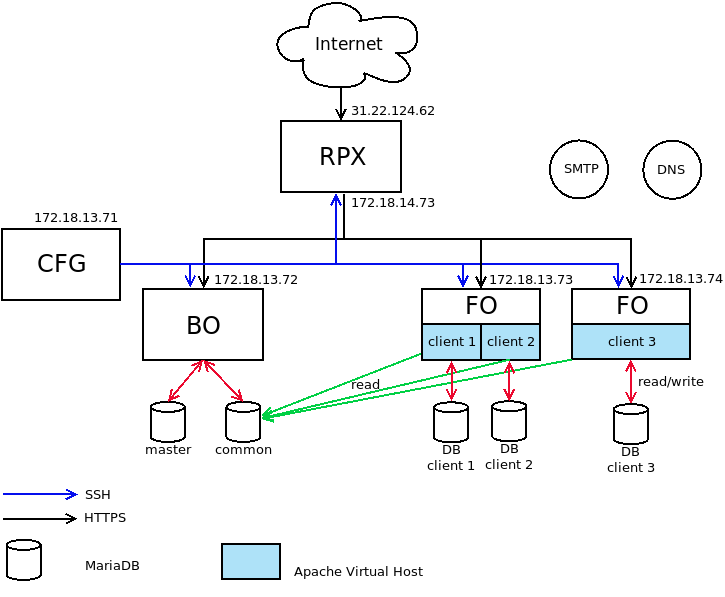This playbook is used to deploy the whole MONARC architecture in accordance to the figure below.
There are three roles, described below.
Common tasks for the front office and the back office.
Backoffice. Only one per environment (dev, preprod, prod...).
Frontoffice. Can be multiple installation per environment to balance to the load.
- Git on all servers;
- Python 2 on all servers. Actually ansible 2.2 features only a tech preview of Python 3 support;
- ansible must be installed on the configuration server;
- Postfix on the BO and all FO servers.
Install ansible on the configuration server and get the playbook for MONARC:
$ sudo apt install python-pip
$ sudo -H pip install ansible dnspython
$ git clone https://github.com/monarc-project/ansible-ubuntu.git
$ cd ansible-ubuntu/
If you encounter a problem of locales, try the following:
$ export LC_ALL="en_US.UTF-8"
$ sudo dpkg-reconfigure locales
-
create a user named ansible on each server:
sudo adduser ansible
-
generate a SSH key for the user ansible on the configuration server:
ssh-keygen -t rsa -C "your_email@example.com"
-
from the configuration server:
ssh-copy-id ansible@BO/FO/RPX -
add the user ansible in the sudo group:
sudo usermod -aG sudo ansible
-
add the user www-data in the ansible group:
sudo usermod -aG ansible www-data
-
give the permission to ansible to use sudo without password:
- add
ansible ALL=(ALL:ALL) NOPASSWD:ALLin the file /etc/sudoers with visudo
- add
-
create a configuration file, inventory/hosts, for Ansible:
[dev] FO [dev:vars] master= "BO" publicHost= "monarc.example.com" [master] BO monarc_sql_password="password" [rpx] RPX.localhost [monarc:children] rpx master dev [monarc:vars] env_prefix="" clientDomain="monarc.example.com" emailFrom="info@example.com" github_auth_token="<your-github-auth-token>" protocol="https" certificate="sslcert.crt" certificatekey="sslcert.key" certificatechain="sslcert.crt" bourlalias="monarcbo" localDNS="example.com"The variable monarc_sql_password is the password for the SQL database on the BO.
-
finally, launch ansible:
ansible@CFG:~/ansible-ubuntu/playbook$ ansible-playbook -i ../inventory/ monarc.yaml --user ansible
ansible will install and configure the back office, the front office and the reverse proxy. Consequently the configuration server should be able to contact these servers through SSH.
Adding/removing an attribute for the ansible inventory can be done with the
script update.sh via cron as the user 'ansible'.
ansible@CFG:~$ crontal -l
/home/ansible/ansible-ubuntu/playbook/update.sh /home/ansible/ansible-ubuntu/playbook/ $BO_ADDRESS `which ansible-playbook`
The script update.sh will:
- update the inventory of ansible;
- launch ansible for the creation/suppression of clients;
- synchronize the template of deliveries.
The add_inventory.py and del_inventory.py scripts are used to dynamically
edit the inventory files of the configuration server. These scripts are used by
update.sh.
You can use list_inventory.py to check all the current clients in the
inventory of ansible. If want to check the connectivity between the
configuration server and the front office servers:
ansible@CFG:~$ ./list_inventory.py ../inventory/ | cut -f 1 -d ' ' | uniq | xargs -n 1 ping -w 1
Generation of the certificate:
sudo openssl req -x509 -nodes -days 1000 -newkey rsa:2048 -keyout /etc/sslkeys/monarc.key -out /etc/sslkeys/monarc.crt
Then provide the address of the certificate (here monarc.crt) and the address of the certificate key in the configuration file (inventory/hosts). You can generally set certificatechain to the empty string.
Generation of the certificate:
sudo -E letsencrypt certonly --agree-tos -m <your-email> --webroot -d <clientDomain> -w /var/www/letsencrypt/
Then simply set the value of certificate to letsencrypt.
And set the values of certificatekey and certificatechain to the empty
string.
Installation of Postfix on the BO and the FO is not done by ansible. You have to do it manually.
ansible keep an up-to-date database backup script on each FO server instances.
This script is located at /usr/local/bin/backup_monarc_db.sh and is updated
by ansible on each client creation/deletion.
You just have to set a cron rule in order to launch the script periodically.
The database backups will be placed in the folder
/var/lib/mysql-backup/monarc/
For security issues please contact us to info@cases.lu.
For other issues (ideas, improvements, etc.), you can directly submit it to GitHub
